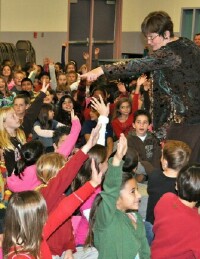 Kids get squirmy. Adults chat. What do you do when their behaviors distract during your presentation?
Kids get squirmy. Adults chat. What do you do when their behaviors distract during your presentation?
Head ‘Em Off at the Pass: Understand that squirms and chattiness usually happen when 1) some event in school has them buzzing, or 2) the audience isn’t engaged. Engagement is key. Plan for this in the body of your presentation. About every ten minutes, change direction or involve the audience in an activity, ask a question, invite a volunteer to help on stage, or reveal a cool prop. Also, when you begin, be sure you’ve established a “quiet” down sign. Either use the school’s system (for example, some have a pattern of claps) or one of your own. (I hold my arms at an angle, palms forward.) Then wait. Don’t begin until they’ve settled. Waiting is essential. If you talk over a half-settled audience, the volume will rise and you’ll have a very hard time getting them back.
The Looky-Loo Effect: Whatever you look at, the kids will look at. This is great when you want them to focus on a prop or an important slide in your presentation. It’s not so great when a kid barfs in the middle of your assembly. (It happened to me! And I hope it wasn’t a commentary on the content of my program . . .) If there’s a disturbance in the room that’s out of your control, know that if you focus on it, the kids will too, and it can be challenge to get their attention back. Take the small stuff in stride so that the focus stays on your program.
Silence is Golden: Are two faculty members chatting together? Walk closer to them as you continue your presentation. Make eye contact. If they continue to chat, you might cover the mike and quietly ask, “Did you have a question?”
Are We There Yet? Have you ever been in a presentation and groaned, “When is this ever going to end?” I have. Audiences want to know in advance what your presentation is going to address. And they want to know when it’s going to end. At the opening of my assemblies for kids, I quickly give them an outline of what they’re going to learn and tell them that we’ll be acting out a story at the end. This way, they know the whole presentation arc will be covered and that you’re not just going to ramble then end when the time runs out.
Do you have any “antsy audience” questions? Or do you have a technique that work well for you? Share!

Great advice, Alexis. You pretty much used up my teacher bag of tricks. The part about involving the audience every ten minutes is key, and this is something that adults who aren’t teachers often forget. Have the whole audience stand up to act out a part in the story if they are super wiggly. Kids are often disappointed when they aren’t called upon, and you can’t call on everyone, so this often helps. I have been known to do something totally crazy and unexpected to get their attention back, usually something gymnastic and dangerous for a woman in her sixties. Ha, ha. But it’s not necessary to injure yourself. You can just start singing or dancing or miming. Make up something related to your story to pull out if needed.
Thanks, Virginia! I love your suggestions to get the whole audience involved in some way, or to do something unexpected. Gymnastics are out for me (!), but I find that if I sing a song, as you mentioned, they settle right down.